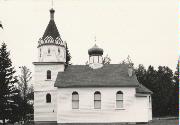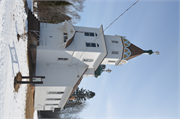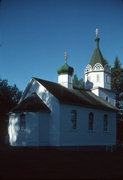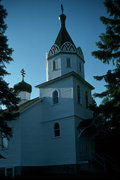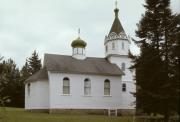Property Record
88340 ERIE AVE
Architecture and History Inventory
| Historic Name: | St. Mary's Russian Orthodox Church |
|---|---|
| Other Name: | St. Mary's Orthodox Church |
| Contributing: | |
| Reference Number: | 1091 |
| Location (Address): | 88340 ERIE AVE |
|---|---|
| County: | Bayfield |
| City: | |
| Township/Village: | Bell |
| Unincorporated Community: | CORNUCOPIA |
| Town: | 51 |
| Range: | 6 |
| Direction: | W |
| Section: | 34 |
| Quarter Section: | SE |
| Quarter/Quarter Section: | NW |
| Year Built: | 1909 |
|---|---|
| Additions: | |
| Survey Date: | 1987 |
| Historic Use: | church |
| Architectural Style: | Front Gabled |
| Structural System: | |
| Wall Material: | Clapboard |
| Architect: | |
| Other Buildings On Site: | |
| Demolished?: | No |
| Demolished Date: |
| National/State Register Listing Name: | Not listed |
|---|---|
| National Register Listing Date: | |
| State Register Listing Date: |
| Additional Information: | CENTRAL HEXAGONAL STEEPLE WITH PAINTED ARCHES. CENTRAL OCTAGONAL CUPOLA WITH ONION DOME. BUILT BY RUSSIAN IMMIGRANTS. PHOTO CODES ARE OWW 0305-11+CS. The Nativity of the Blessed Virgin Mary Church, rich in religious symbolism, is one of several Russian Orthodox churches in rural Wisconsin. The Russian Orthodox Church was established in North America in Russian-controlled Alaska in 1794. Until the 1880s, most Orthodox Christians in North America were native Alaskans, but in the late nineteenth century, a great migration brought many East Slavs from Europe. Although these East Slavs were not Russians, a movement that started in the Upper Midwest brought many of the immigrants into the Russian Orthodox Church's North American diocese, increasing its size and transforming its ethnic character. In 1970 this former diocese became a completely independent Orthodox Church in America. Shortly after 1900, East Slav families, originally from the Austro-Hungarian Empire and from Ukraine (then part of the Russian Empire), settled in Bayfield County to farm or work in the sawmills. They constructed this church about 1910. The church is set on the edge of the village, on elevated ground. The exterior, clad in white wooden clapboards, articulates its three-part plan: the entry or narthex; the compact nave where the congregation gathers for worship; and, at the east end, an eight-sided apse enclosing the sanctuary. The roof forms are the most striking exterior features. Perhaps due to the influence of clergy from Russia or a Russian Orthodox Church pattern book, the roofline uses a distinctly Russian architectural vocabulary. The tower has a tent-shaped roof known as a shaytor, surrounded by decorative wood panels, apparently suggesting external arches called kokoshniki. The kokoshniki are painted blue and gold, traditional colors for Russian Orthodox church roofs. At the top of the shaytor is a small onion dome raised on a small cupola; a larger onion dome set on a cupola marks the center of the nave. Both domes are topped with gold three-bar Russian Orthodox crosses. The roofline of the door hood over the west door employs a subtle reverse curve, another motif common in Russian architecture. The front of the door hood is enlivened by a flowing folk-design of jigsaw work also incorporating a three-bar cross. A miniature onion dome crowns the top of the hood. Clearly the dome is used here not to cover space but to symbolize the Orthodox church. On the interior, three steps above the nave, a platform supports the iconostasis, or icon screen, separating the sanctuary from the nave. The iconostasis is pierced by paired royal doors at the center and one deacon door on each side. This iconostasis holds two tiers of icons, designed to connect the worshiper to the life of Christ, his saints, and the heavenly realm. The nave reflects the Orthodox tradition of standing for worship without pews. Today, however, pews fill the space beneath an azure blue ceiling accented with gold stars. Toward the front of the nave are a large chandelier, icon church banners, candle stands, and a stand holding an icon. The Nativity of the Blessed Virgin Mary Church is connected by history and related in design to several other Orthodox churches in rural Wisconsin including Holy Trinity, St. John the Baptist (Town of Colburn, Chippewa County), and Holy Assumption (Village of Lublin, Taylor County). |
|---|---|
| Bibliographic References: | WISCONSIN PRESERVATION, DHP NEWSLETTER, VOL. 18, #6, NOV./DEC. 1994. Buildings of Wisconsin manuscript. |
| Wisconsin Architecture and History Inventory, State Historic Preservation Office, Wisconsin Historical Society, Madison, Wisconsin |

